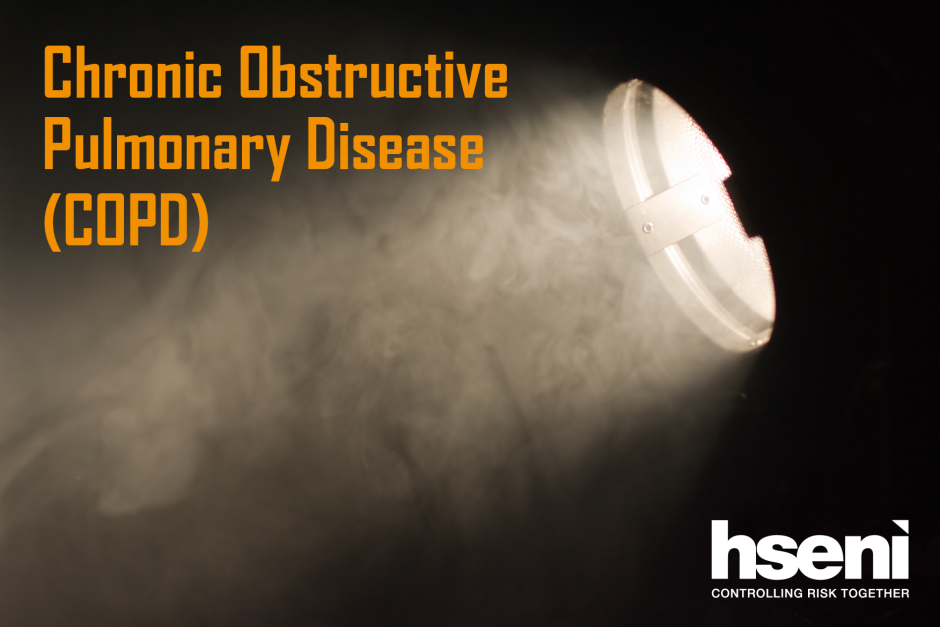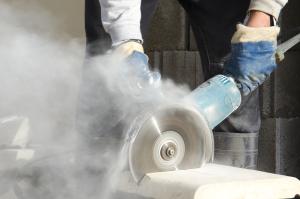What is Chronic Obstructive Pulmonary Disease?
Chronic Obstructive Pulmonary Disease (COPD) is the name given to a group of lung conditions that cause breathing difficulties. These include:
- emphysema - damage to the air sacs in the lungs
- chronic bronchitis - long-term inflammation of the airways

COPD is a serious long-term lung condition that mainly affects middle-aged or older adults who smoke or are exposed to substances at work.
It is a progressive and irreversible lung condition which limits the airflow in the lungs. Many people do not realise they have it until symptoms advance or they undertake physical activity.
COPD is the fourth biggest killer globally and while smoking is considered to be the most significant cause, exposure to dusts and other substances can lead to COPD developing, even in those who do not smoke.
Statistics produced by the Health and Safety Executive (HSE GB) show that COPD can be caused or made worse by dusts, fumes and irritating gases at work:
Preventing employees developing work related COPD is a priority due to:
- the human costs in terms of suffering
- the effects it has on the sufferer’s quality of life
- the financial implications due to working days lost, medical treatment and aftercare
Research suggests that in Great Britain:
- around 15 percent of COPD may be caused or made worse by work
- 4000 COPD deaths may be related to work exposures every year (equivalent to approximately 120 deaths in NI)
- 40 percent of COPD patients are below retirement age
- a quarter of those below retirement age are unable to work due to their condition
What are the symptoms of COPD?
Common symptoms of COPD include:
- shortness of breath - this may only happen when exercising at first, and you may sometimes wake up at night feeling breathless
- a persistent chesty cough with phlegm
- frequent chest infections
- persistent wheezing
Information on COPD can be found on the NHS website via the link below:
COPD is a slow developing, progressive condition, the symptoms of which usually start becoming apparent in mid-life i.e. the late forties onwards.
The progression of COPD is usually slow with many employees not realising they have the disease and think their symptoms are due to a lack of fitness or getting older. This means that the disease often goes undiagnosed in its early stages. Early diagnosis is paramount for a more positive outcome and quality of life.
When a person identifies that they have lung related issues they should try to stop smoking, (if they do smoke) and reduce/eliminate harmful exposures to dusts, fumes and gases.
Some medical treatments may help, however there is no cure. COPD can usually be slowed/stopped at the stage where harmful exposures, including smoking, are stopped so that the quality of life is maximised and is manageable.
If you have any concerns with regard to your health, you should speak to your GP as soon as possible.
What causes COPD?
By far the main cause of COPD is smoking, however occupational exposures to dusts, fumes and irritant gases can also cause this debilitating condition.
What substances can cause COPD?
A wide variety of dusts or fumes have the potential to cause COPD if exposure is high and over a prolonged period of time. The following substances have the potential to cause COPD:
- cadmium fumes
- grain and flour dust
- mineral dust
- organic dusts
- silica dust
- welding fumes
Some of these substances are linked to other diseases, for example, welding fume can cause fume fever, pneumonia and is classified as a carcinogen. Some can also cause occupational asthma.

Dust may be present within your work environment, but not visible under normal working conditions.
The fine dust that works its way into the lungs, known as respirable dust, may only be visible if strong light is shone onto the dust particles.
High risk occupations
HSE GB research, COPD causes - occupations and substances, concluded that occupations and industries with a higher risk of developing COPD include:
- agriculture
- brick making
- cadmium
- mining
- construction
- dock workers
- flour and grain workers in the food industry
- foundry workers
- petroleum workers
- quarries
- rubber
- plastics
- stonemasonry
- textiles
- welders
If you work in any of these industries and are also a smoker, the risk of developing COPD is likely to increase due to the combination between the health effects of smoking and the health effects of dusts and fumes exposure.
What controls should be put in place?
Employers


Due to the multiple causes of COPD in the workplace, it is not possible to provide ‘a one size fits all’ list of controls. For example, water suppression that is effective in reducing the risk from silica when cutting kerbstones, would not be effective in controlling the risk from grain dust as this process must remain dry.
The following general principles for risk reduction apply:
- preventing dusts, fume and irritant gases from getting into the air in the first instance eliminates exposure
- the use of water suppression or wet techniques when including cutting, grinding or blasting can be effective
- use dust-reduced materials for example pellets, tablets, solutions or pastes and use pre-weighed material in sealed bags where possible
- segregate - keep employees separate from contaminants by putting dusty machinery in a separate room or automate the process
When a substance or substances meets the definition of a ‘substance hazardous to health’ under the Control of Substances Hazardous to Health Regulations (NI) 2003 (COSHH NI), the employer is required by law to control exposures to such hazardous substances in order to protect employees' health as follows:
- assess the risks
- apply the hierarchy of control:
- elimination - physically remove the hazard
- substitution - replace the hazard
- engineering controls - isolate people from the hazard
- administrative controls - change the way people work
- PPE/RPE - protect the worker with Personal Protective Equipment (PPE)/Respiratory Protective Equipment (RPE)
- provide health/medical surveillance or health monitoring as appropriate for workers at risk
Employees


Due to the multiple processes within industries, and the diverse nature of the dusts and fumes that can cause COPD, it is not possible to provide a single list of ways employees can protect themselves. However, employees are required to cooperate with their employer and, where applicable, should:
- vacuum clean - avoid dry brushing or blowing equipment with compressed air
- handle materials 'gently' - minimise the distance they fall or are thrown, reduce machine speed/power to minimise the amount of dust ejected
- improve work practices - don't drop material and avoid creating draughts
- adequately control waste - use closed bags or containers, don’t let wet waste dry out and remove frequently from the workplace, (ensure good housekeeping)
- where possible, avoid grinding and sawing with power tools and ensure all equipment is maintained correctly
- keep machinery clean
- use effective local exhaust ventilation (LEV) correctly
- use RPE when required - make sure the wearer is face fit tested for the correct RPE and trained in its correct use
- store RPE in a clean, closed container when not in use
Health monitoring and health surveillance for COPD
If a substance is likely to cause COPD in your workplace, then you will need to consider whether health surveillance is required for compliance with COSHH. This may be the case, for instance, if your employees use cadmium. You should seek the help of a competent advisor.
For a substance where the evidence linking it with COPD is less certain, then it is recommended that you still consider health monitoring of your employees:
Health surveillance, or monitoring would involve an assessment of individuals' fitness for work at the start of employment by means of symptom enquiry and lung function testing. Thereafter employees should be asked about new or worsening respiratory symptoms and have a repeat lung function test at regular intervals as defined by your occupational physician.
Information arising from health surveillance and monitoring of individuals, and groups of employees can help you assess whether the control of COPD causing substances in your workplace are adequate.
Some substances that cause COPD also cause occupational asthma (OA). Any occupation where there is a risk of OA requires regular health surveillance.
Resources
- Asthma
- Control of Substances Hazardous to Health (COSHH)
- COSHH (NI): A brief guide to the Regulations
- Welding fume - Article
- Welding fume - Topic page
- A step by step guide to COSHH assessment HSG97 - (hse.gov.uk)
- Chronic obstructive pulmonary disease (COPD) - (hse.gov.uk)
- Control of Substances Hazardous to Health. Approved Code of Practice and guidance (L5) - (hse.gov.uk)
- Control of Substances Hazardous to Health (COSHH) - (hse.gov.uk)
- Controlling airborne contaminants at work: A guide to Local Exhaust Ventilation (LEV) HSG258 - (hse.gov.uk)
- Dust and pollutants at work - HSE Go Home Healthy Campaign video (youtube.com)
- EH40/2005 Workplace exposure limits - (hse.gov.uk)
- Health surveillance and occupational health - (hse.gov.uk)
- Industry respiratory health links A-Z - Lung disease - (hse.gov.uk)
- Work-related Chronic Obstructive Pulmonary Disease (COPD) statistics in Great Britain 2024 - (hse.gov.uk)
- Asthma + Lung UK - COPD (asthmaandlung.org.uk)
- Centre for Occupational & Environmental Health, University of Manchester - (manchester.ac.uk)
- Department of Health and Social Care - An outcomes strategy for COPD and asthma in England - (gov.uk)
- Education for Health - (educationforhealth.org)
- Industrial Injuries Advisory Council - (gov.uk)
References
- Chronic obstructive pulmonary disease (COPD) - (who.int)
- Work-related Chronic Obstructive Pulmonary Disease (COPD) statistics in Great Britain, 2024 - (hse.gov.uk)
- Prevalence and incidence: Background information - Chronic obstructive pulmonary disease - (cks.nice.org)
- Definition, epidemiology, and risk factors - (pmc.ncbi.nlm.nih.gov)
- Definition, epidemiology, and risk factors - PMC - (pmc.ncbi.nlm.nih.gov)